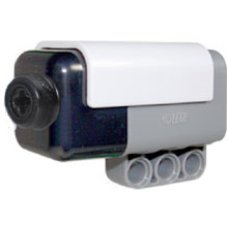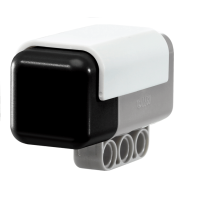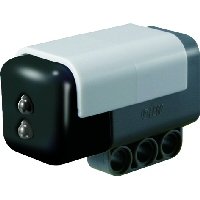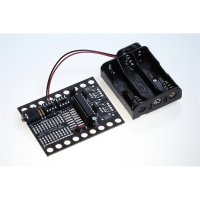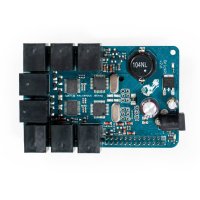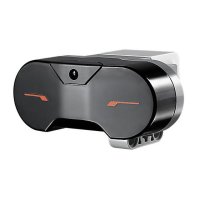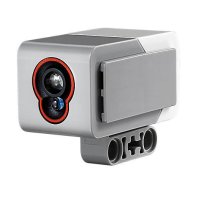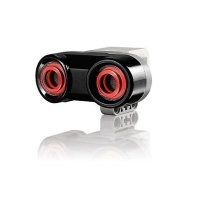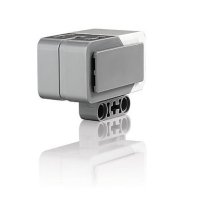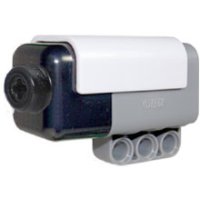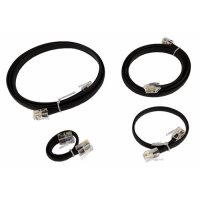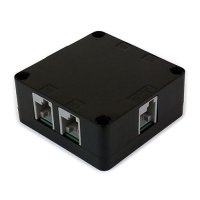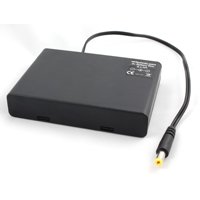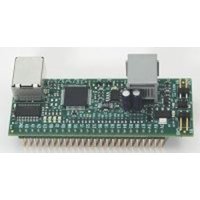- Absolute Angle: the rotation angle of an axle from 0 degrees to 359 degrees, accurate to 1 degree.
- Accumulated Angle: the accumulated multiple rotation angle measured since the last reset function was performed.
- Revolutions per Minute (RPM): the current estimate of rotation rate from 1 RPM up to 1,000 RPM.
- The Angle sensor is ideal for building into complex models where monitoring the shaft angle or location and / or the speed of rotation is desired.

- Absolute Angle: the rotation angle of an axle from 0 degrees to 359 degrees.
- Accumulated Angle: the accumulated multiple rotation angle measured since the last reset function was performed.
- Revolutions per Minute (RPM): the current estimate of rotation rate from 1 RPM up to 1,000 RPM.
- Using data wires, it can send out the current angle of rotation and a logic signal (true/false) based on whether the current heading falls inside or outside a trigger range.

- The number shows which of your NXT's ports are connected to the Angle sensor. You can change this number in the configuration panel if you need to.
- The block's data hub will open automatically when the block is placed in the work area. At least one data wire must be dragged from the block's output plug to another block's data hub. The trigger range and other features can be set dynamically by connecting an input data wire. (See the Data Hub section below for more information.)
Configuring the Angle Sensor Block

Image of configuration panel
The sensor may be connected directly to an NXT sensor port or via the HiTechnic Sensor Multiplexer (MUX). When configuring the sensor via the multiplexer, there are two port selections to make. The first is the NXT to MUX connection and the second, the MUX to SENSOR connection.

- This plug wires the number for which of your NXT's ports are connected to the compass sensor.
- This plug wires the Angle output.
- This plug wires the RPM output.
- This plug wires the Accumulated angle output.
- This plug wires the Action input, 0 = Read, 1 = Calibrate, 2 = Reset.
- This plug wires the Range selection for inside/outside range function, 0 = Inside Range, 1 = Outside Range.
- This plug wires the lower range limit number for the Inside/Outside compare function.
- This plug wires the upper range limit number for the Inside/Outside compare function.
- This plug outputs the Inside/Outside logical value.
- This plug is set to true if the sensor is connected via the HiTechnic sensor multiplexer.
- this plug wires the number of the multiplexer port connected to the sensor .
Sensor Register Layout
| Address | Type | Contents |
|---|---|---|
| 41H | byte | mode control |
| 42H | byte | angle in 2 degree increments |
| 43H | byte |
1 degree angle adder
|
| 44H | long | Accumulated Angle |
| 48H | int | RPM - Rotations Per Minute |
Lego Mindstorms NXT Angle Sensor
- Brand: HiTechnic
- Product Code: Hitechnic-NXT-Angle-Sensor
- Reward Points: 69
- Availability: Order now and get it in 07 days
-
रo 6,920.00
- Price in reward points: 6920
Related Products
Lego Mindstorm Acceleration / Tilt Sensor for NXT / EV3
Now you can make robots that know which way is up! The Accelerometer / Tilt Sensor measures accelera..
रo 6,920.00 रo 7,550.00
Lego Mindstorms Magnetic Compass Sensor for NXT / EV3
Expand your NXT experiences with the new NXT Compass Sensor and add accurate navigation to your Mind..
रo 7,385.00 रo 7,550.00
Lego Mindstorms Infrared Seeker V2 for NXT / EV3
Play robot soccer and zero in on your infrared (IR) beacons with IRSeeker. You can use most TV remot..
रo 6,920.00 रo 6,985.00
Lego Mindstorms Color Sensor V2 for NXT / EV3
Add a spectrum of color to your models with the new and updated Color Sensor. Detect an extended ran..
रo 6,920.00 रo 7,550.00
PICAXE I2C Explorer Kit AXE216
A self-assembly kit for the PICAXE-20X2 (included) for those wishing to interface and experiment wit..
रo 1,350.00
BrickPi+ Base Kit
BrickPi is best for someone who already has LEGO MINDSTORMS sensors and motors. The BrickPi connects..
रo 17,563.00
EV3 Infrared Beacon
This has been designed for use with the EV3 Infrared Seeker Sensor. The beacon emits an infrared sig..
रo 4,425.00
EV3 Infrared Sensor
The digital EV3 Infrared Seeking Sensor detects proximity to the robot and reads signals emitted by ..
रo 4,425.00
EV3 Color Sensor
The digital EV3 Color Sensor distinguishes between eight different colors. It also serves as a light..
रo 5,175.00 रo 5,885.00
EV3 Ultrasonic Sensor
The digital EV3 Ultrasonic Sensor generates sound waves and reads their echoes to detect and measure..
रo 4,425.00
EV3 Gyro Sensor
The digital EV3 Gyro Sensor measures the robot’s rotational motion and changes in its orientation. S..
रo 4,425.00
Lego Mindstorms NXT Magnetic Sensor
The NXT Magnetic Sensor will enable you to build robots that can detect magnetic fields. The sensor ..
रo 2,865.00
Lego Mindstorms NXT IR Receiver Sensor
The NXT IRReceiver Sensor receives signals from a LEGO Power Functions IR remote control, decodes th..
रo 6,280.00
Lego Mindstorms NXT EOPD
Accurately detect objects and small changes in distance to a target with the HiTechnic EOPD. The EOP..
रo 6,920.00
Lego Mindstorms NXT Force Sensor
The NXT Force Sensor will enable you to build robots that can measure a physical force applied throu..
रo 5,000.00
Lego Mindstorms NXT Barometric Sensor
The NXT Barometric Sensor can be used as part of a weather station or to monitor altitude. The senso..
रo 6,920.00
HiTechnic NXT Extended Connector Cable
Extend your Mindstorms NXT robotic designs with the HiTechnic Extended Connector Cable . Build creat..
रo 100.00
HiTechnic NXT Touch Sensor Multiplexer
HiTechnic NXT Touch Sensor Multiplexer for LEGO Mindstorms NXT Introduction The NXT Touc..
रo 3,610.00
HiTechnic 9V-6xAA Battery Box
This Battery Box can be used to power the 360 IR Beacon replacing the beacon's optional 9v internal ..
रo 645.00
HiTechnic NXT SuperPro Prototype Board
HiTechnic SuperPro Sensor for LEGO Mindstorms NXT Introduction The HiTechnic SuperPro Sensor..
रo 3,400.00
Tags: NXT, Angle, Sensor, Lego, Mindstorms

